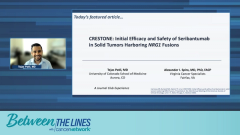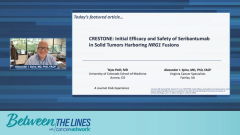
CRESTONE Trial of Seribantumab in Solid Tumors With NRG1 Fusions: Trial Design and Safety Data
Expert perspectives on the trial design of and safety data from CRESTONE, which analyzed seribantumab therapy in solid tumors with NRG1 fusions.
Episodes in this series

Transcript:
Tejas Patil, MD: Welcome to this CancerNetwork® Between the Lines program. Today’s featured article is “CRESTONE: Initial Efficacy and Safety of Seribantumab in Solid Tumors Harboring NRG1 Fusions.” I’m Dr. Tejas Patil and I’ll be discussing this conference abstract with my colleague Dr Alexander I. Spira.
NRG1 gene fusions are seen in solid tumors, they’re rare genomic alterations that result from the fusion of NRG1 with the partner gene. There are several fusion partners that have been identified; CD74 is one of the more common ones, but it is not the only one. What is interesting about NRG1 fusions is that they bind and tend to activate HER3, and importantly they are mutually exclusive of other known oncogenic alterations. So when we have an NRG1 fusion, we can be positive that it is likely the main oncogenic driver that is causing oncogenesis in the cancer. It’s found in 0.2% of all solid tumors, so they are quite rare. There is a certain subset in which we do seem to have more enrichment of these cases, and that is in KRAS wild-type pancreas cancers and invasive mucinous adenocarcinoma of the lung. Part of the challenge with NRG1 fusions has really been in the detection of these rare gene fusions, largely because of intronic regions within the gene fusion. Because of this, RNA-based sequencing really is a gold standard for detecting these. Patients with these tumors have historically had poor outcomes with standard therapies; this has included chemotherapy and immunotherapy. Until this ASCO [American Society of Clinical Oncology meeting] there were really no approved targeted therapies or even really effective therapies for patients with these NRG1 fusions, and we’ll talk about some of the data presented on seribantumab in this talk.
Seribantumab inhibits NRG1 fusion tumor growth. What it is is a fully human anti-HER3 IgG2 monoclonal antibody. It competes with NRG1 to bind to HER3, and so what it is doing is [it] prevents dimerization and phosphorylation of HER3 and other HER family members, and then this is thought to inhibit downstream signaling. Seribantumab inhibited tumor growth and regression in preclinical models, and that’s shown in the bottom left. The comparator here is afatinib, which, although not approved for this indication, clinically has been, prior to this monoclonal antibody, a very common therapy that we have used for patients with these fusion types.
On this observation, a phase II study of the anti-HER3 monoclonal antibody and seribantumab in solid tumors with NRG1 fusions was conducted. The key inclusion criteria are shown on the left. It was an open trial in the sense that any patient with locally advanced metastatic solid tumors harboring an NRG1 gene fusion was eligible. Patients had to have a minimum of 1 line of prior systemic therapy. These gene fusions typically tend to be mutually exclusive with other oncogenic drivers, but for the purposes of being very explicit, no other oncogenic drivers were allowed except for in cohort 3. The safety run-in phase was conducted initially as an induction, consolidation, and maintenance dosing, and ultimately seribantumab was dosed at 3g IV [intravenous] Q [once] weekly. The primary end point is shown here; it is objective response rate by independent central radiologic review. Secondary end points include safety, objective response rate by investigator assessment, and then other end points include duration of response, PFS [progression-free survival], OS [overall survival], and there are several exploratory endpoints for cohorts 2 and cohorts 3.
These are the patient demographics and disease characteristics for patients included in this cohort. In the safety population, there were 35 patients. In cohort 1, which was optimized to receive 3g weekly, which was RP2D [recommended phase II dose], there were 15 patients. There was a female predominance within the cohort, and most patients had good performance status. Within cohort 1, non–small cell lung cancer was the most common cancer subtype harboring NRG1 fusions, within the safety population there was a more even distribution among hepatobiliary carcinomas, breast carcinomas, and non–small cell lung cancer. Fusion partners are shown here. Like I mentioned, CD74 is the most common, but it is not the only one, and others have been observed. The median prior systemic therapies for cohort 1 was 1, and in the safety population it was 2. Dr Spira, do you have any thoughts about how well balanced this is, or any comments on some of the initial data presented here on the demographics and disease characteristics?
Alexander I. Spira, MD, PhD, FACP: This is typical for what we would like to see. I think that we know lung cancer is probably the most common type that exists out there, but I do think that it is representative [of what we like to see]. I think that my take-home message is to remind everybody that there are a lot of different fusion partners here, so as we look at the data, one of the things to do is making sure that the data holds a coin to all the different fusion partners. I think a reminder to the fact that this is going to be something that we need to detect by RNA rather than DNA-level analysis.
Tejas Patil, MD: Yes, that’s a very good point. Next slide, please. This is a safety summary of seribantumab monotherapy. What we’ve seen here is that adverse events [AE] are reported in greater than 15% of patients, mostly grade 1 and grade 2. The common adverse events, specifically treatment-emergent AEs and treatment-related AEs, seem to be diarrhea, fatigue, and rash. Presumably this is due to some off-target ERBB inhibition, and the hypokalemia is presumably related to diarrhea losses. There was 1 DLT [dose-limiting toxicity] of grade 2 fatigue that resulted in dose reduction by investigators in the safety run-in. Seventy-seven percent of patients did receive the 3g weekly dose. As I point out here, the majority of the treatment-related adverse events were grade 1 or 2, so this was in general a very well tolerated therapy, with only 2 patients receiving dose reductions per discussion with the investigator. More importantly, no patient discontinued seribantumab for adverse effects. Dr Spira, what do you make of these data?
Alexander I. Spira, MD, PhD, FACP: I think that my only take home is that this is a rare mutation, so clearly you’re selecting a population that would travel. This is not something that is open to every single community site in the world. We have the study here, but I imagine you are self-selecting for healthier population. I call it the “MD Anderson effect”—those patients who are physically able to get to a study site, although there are some community sites on here. So I think [it’s] taking with a grain of salt that 77% of patients got the recommended phase II dose of 3g a week. I’m a little bit concerned there because I think in [the] real world we will probably see a little bit of a higher number. Remember, [it’s] a rare population: patients that can travel, and patients that of course are enrolled in the study where you are getting really intense monitoring. So I expect it to go up, but honestly, I think it is pretty well tolerated.
Tejas Patil, MD: I would agree, and when you think about the patient demographics, most of these being non–small cell lung cancer, even pancreatic or hepatobiliary cancers, many of them have been pretreated. There is a sort of selection effect that’s happening, where the fittest of the fit among that subgroup are able to potentially enroll. With that being said, this being a monoclonal antibody, there isn’t cytotoxic payload like you would see in antibody-drug conjugate, so this side effect profile is encouraging. The Q weekly dosing, do you have any thoughts on that from a logistic standpoint as this becomes a therapy that we are potentially thinking about using in the real world? How do you think that is going to affect [INAUDIBLE]?
Alexander I. Spira, MD, PhD, FACP: There’s always a concern. Two things: 1 is when people get a drug that works, they’ll do anything. The first thing is, “I have a drug that works for this rare mutation”—that’s everything. Then you hit cycle 2 and it’s: “Do I really have to come in once a week?” I think we are experiencing that a little bit with—I’ll give you an example of amivantamab and EGFR Exon20. It sounds great that it works, but the every-other-week [dosing] gets old after a while, and here you are talking about every week. It is going to be a logistical challenge, especially if it gets FDA approval and gets out to other sites. Of course we would love to see less-frequent dosing, but I think with something like this, right now, we will take it as it’s worth.
Tejas Patil, MD: Very good point.
Transcript edited for clarity.
Newsletter
Stay up to date on recent advances in the multidisciplinary approach to cancer.

























































































